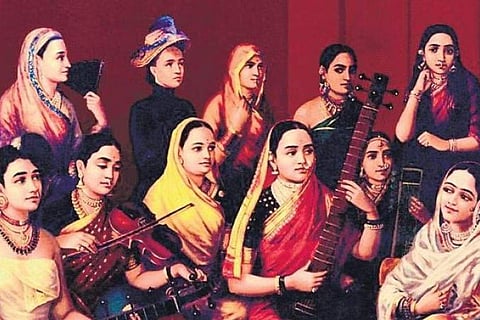
- LIFESTYLE
- FASHION
- FOOD
- ENTERTAINMENT
- EVENTS
- CULTURE
- VIDEOS
- WEB STORIES
- GALLERIES
- GADGETS
- CAR & BIKE
- SOCIETY
- TRAVEL
- NORTH EAST
- INDULGE CONNECT

The month of December in Chennai is synonymous with the annual Margazhi festival of dance and music. Popularly known as the December season, the month-long festival is a celebration of Carnatic music and traditional dance forms.
Dating back to December 1927, when the first music festival was held at the Madras Music Academy, a year before the Academy was formally inaugurated, the concept was soon followed by other music organisations, or sabhas, across the city. Today, it is the most sought after destination for melophiles.
Music and dance is an essential part of human existence. In ancient India, it was often associated with divine worship. Art bears testimony to what our ancient music and dance traditions were, with sculptures, paintings and inscriptions serving as a documentation of this history.
Cave drawings
Prehistoric cave art has abundant evidence of dance and music being a part of the life of our early ancestors. The Pachmarhi Hills situated in Madhya Pradesh, are covered with rock art belonging to the Mesolithic times made by early inhabitants which depict dance and music. Dance seems to have been an important part of their ceremonies and also served as entertainment.
Headdresses and animal masks representing crocodiles, bulls, monkeys and donkeys were worn and most of the dancers were interestingly, featured in pairs or rows, playing musical instruments. The chalcolithic cave drawings found in other regions in India also illustrate several musical instruments. The most famous find at the Indus Valley Civilisation site of Mohenjo-daro was the bronze sculpture of The Dancing Girl — a fine proof that music and dance was celebrated enough to create such masterpieces.
The many forms of music
Old temple paintings and sculptures show that classical Indian musicians used almost the same kind of instruments that are used in today’s times. Natya Shastra by Bharata Muni, the ancient text on performing arts, categorises musical instruments into four categories — percussion, solid, wind and string instruments. The mridangam is a percussion instrument that can be traced back to very ancient eras. Early sculptures and paintings show the mridangam as the instrument of a plethora of deities.
According to Hindu mythology, Nandi is said to have played the mridangam during Lord Shiva’s cosmic dance. The Ravanahatha, another ancient instrument, which is sometimes called an ancestor of the violin, is believed to have originated in Sri Lanka during the reign of King Ravana and hence the name. The sound box was made of a gourd, a halved coconut shell or a hollow piece of wood with a membrane of goat hide. Bamboo or wood was attached, carrying strings of gut or hair, strung over a bridge. This stringed instrument was very popular, especially among royalty because in medieval India, it was the kings who generously patronised music.
The flute is one of the most common musical instruments found in early sculptures and paintings in India. In Hindu mythology, Lord Krishna is epitomised as the divine flute player. Sculptures and paintings showing him thus can be found in numerous styles all over the country. There is even an 8th century sculpture of Krishna playing the flute in the Todai-ji Temple in Nara, Japan. Though a Buddhist temple built in the Tang dynasty era, the presence of Krishna playing the flute only goes to show that Indian philosophy was accepted and adopted by the Japanese.
Other than the traditional musical instruments, Indian art history is replete with representations of snake charmers. The pungi, a wind instrument used by them, attracts these reptiles with its sound and movement. A simple folk music instrument made from dry hollowed gourd with two bamboo attachments, the pungi has been associated with the nation’s image as the land of snake charmers.
Temple sculptures
Indian temples are known for their graceful sculptures. The Arunachaleswara Temple in Tiruvannamalai which finds reference in texts dating back to the 1st century BCE is adorned with exquisite sculptures and carvings. One of these carvings depicts a group of musicians with their instruments.
The main sculpture at the Chidambaram Temple in Cuddalore district is the representation of Lord Shiva as the celestial dancer, Nataraja. Lord Nataraja is an iconic image in Indian art and is an expression of energy, cosmic balance and rhythm. He holds a damaru (a small two-headed drum) which represents the power of creation.
Dance is everywhere in this temple. The 108 dance poses are illustrated in the gopurams or towers. However, the carvings on the temple, though depicting the 108 karanas, illustrate choreographed movements from a procession or a ritual. Most of the dancers here are shown with accompanying musicians.
Ravi Varma’s galaxy
India’s most famous artist, Raja Ravi Varma, created an oil painting titled ‘A Galaxy of Musicians’ in 1889 for the Maharaja of Mysore, Chamarajendra Wadiyar X, which has 11 women who appear engrossed in an elaborate musical performance. While some of them hold both traditional Indian and Western instruments, the others seem to listen. The women are from different cultural backgrounds but despite their differences, they emerge united in music. The painting is now housed at the Jaganmohan Palace in Mysuru.